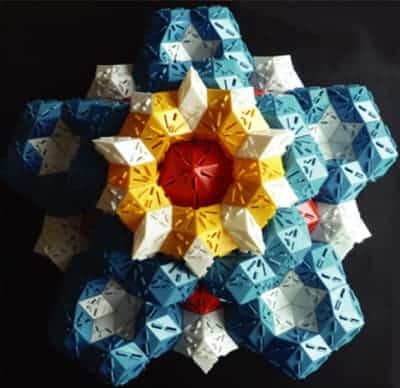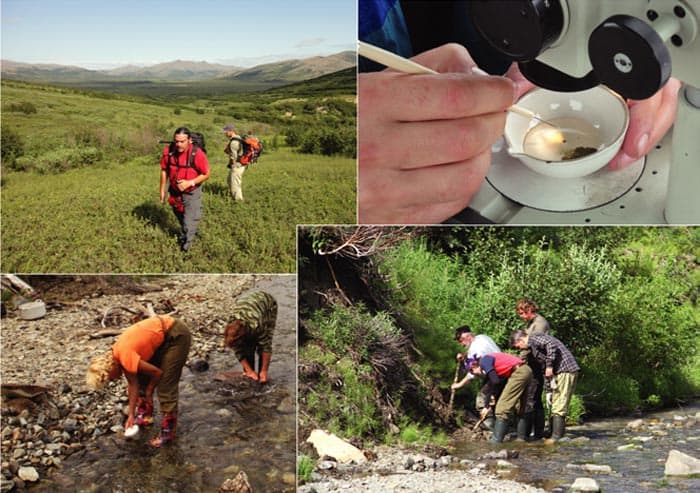
An international team of researchers has found nine new samples of naturally occurring quasicrystals. The work also provides further proof that quasicrystals were delivered to the Earth by a meteorite. The team’s discovery challenges our understanding of both crystallography and solar-system formation.
Conventional crystal structures are made of atoms, or clusters of atoms, that repeat periodically. These patterns are normally restricted to two, three, four or sixfold rotational symmetry – the numbers corresponding to how many times the crystal appears the same during a rotation through 360°. For a long time these were considered hard and fast rules, and no crystals that broke these conditions were thought to exist.
Ordered, but not periodic
However, Israeli physicist Daniel Shechtman found just such a rule-breaking crystal in 1984 and was awarded the 2011 Nobel Prize for Chemistry for his efforts. Shechtman had discovered a quasicrystal – a crystal that, while ordered, does not contain structures that repeat periodically. Schectman’s crystal also had 10-fold rotational symmetry. Even after his discovery, there was a lot of scepticism about the existence of such a material. But as the years went by, other physicists began to construct quasicrystals of their own and now more than 100 different types have been found. These, however, are synthetic and have been created under precisely controlled laboratory conditions. Just as it was originally assumed that quasicrystals could not exist, after their discovery it was assumed that they could not exist naturally in the wider world.
That assumption was called into question in 2009 when Princeton University’s Paul Steinhardt – the man who originally coined the term “quasicrystal” – appeared to have discovered a naturally occurring variety in a rock sample from Russia. Steinhardt and his colleague Luca Bindi, from the University of Florence, Italy, measured the ratio of oxygen isotopes within the sample and their results suggested that the rock belongs to a class of meteorites known as carbonaceous chondrites. Not only did this rock contain a naturally occurring quasicrystal, it also came from outer space.
Thrilling past
But the scepticism that had followed quasicrystals around since their discovery continued. The rock sample was traced back to Valery Kryachko, a Russian who in 1979 had been panning for platinum in a stream flowing through the Koryak mountains in far-eastern Siberia. The rock had somehow turned up in Bindi’s museum collection in Italy. “People were sceptical of the rock’s back story as the tale of how it got to Florence involves secret diaries, smugglers and KGB agents,” Steinhardt told physicsworld.com.
“The only way to settle the debate was to take a shot at finding more samples,” Steinhardt explains. He put together a team of 10 scientists, two drivers and one cook and set out on a four-day expedition across Siberia back to the stream where Kryachko had found the original sample. Once there, they panned 1.5 tonnes of sediment from the stream bank, eventually isolating a few kilograms for analysis.
After six weeks of painstaking grain-by-grain analysis, they hit on something special. “We found a grain with a fleck of metal on it. Not only did it contain quasicrystals, but the oxygen-isotope ratio was exactly the same [as the original sample],” says Steinhardt. “It was an incredible moment. Out in the field, no-one bet on a more than 1% chance of successfully finding anything,” he adds. The team isolated a total of nine quasicrystal samples. It is thought these samples all come from the same meteorite, and analysis of the sediment layers suggests it landed within the last 15,000 years.
Extreme formation
As the quasicrystals come from a carbonaceous-chondrite meteorite, they must have formed in the earliest days of the solar system. Carbonaceous chondrites are thought to have collided together to form the cores of the rocky planets, and so Steinhardt’s quasicrystals are older than the Earth itself. However, current models cannot account for the presence of these quasicrystals. “We need a novel kind of geological process to form them and so it challenges our ideas of solar-system formation,” Steinhardt says.
The intense conditions present in the solar system’s youth also challenge the prevailing view of quasicrystals as objects that need a carefully controlled laboratory set-up to produce. “Quasicrystals are not the delicate materials previously thought. The ones we found must have been formed under robust and hardy conditions in the early solar system,” Steinhardt says.
Others agree that the world of quasicrystals could be changed by this 10-fold increase in the number of known naturally occurring examples. “This result emphasizes how normal quasicrystals are and will hopefully make them less of an eccentricity,” Renee Diehl, a surface physics researcher at Pennsylvania State University, US, told physicsworld.com. “It opens our eyes to the fact that they may have been all around us and we just have not noticed,” she explains.
The research is published in Reports on Progress in Physics.




